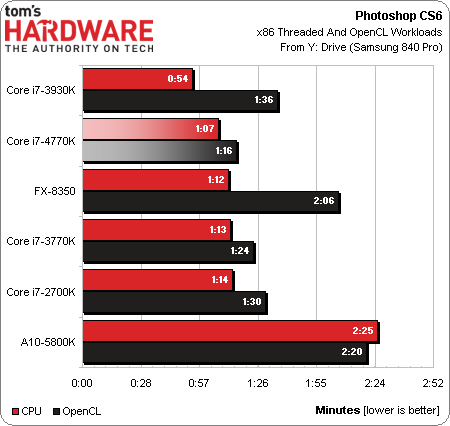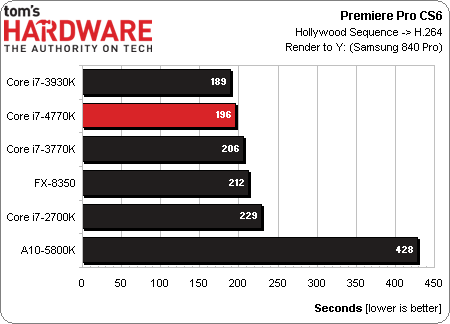The Core i7-4770K Review: Haswell Is Faster; Desktop Enthusiasts Yawn
Intel's Haswell architecture is finally available in the flagship Core i7-4770K processor. Designed to drop into an LGA 1150 interface, does this new quad-core CPU warrant a complete platform replacement, or is your older Sandy Bridge-E system better?
Results: Adobe CS6
We use two distinct Photoshop benchmarks, one of which fully taxes each processor’s x86 cores using well-threaded filters, and another that is OpenCL-optimized to leverage graphics resources. Don’t compare the black and red bars above—they’re only together to save space (and your scrolling finger).
Beginning with the CPU-only benchmark, according to which this chart is ordered, Intel’s Core i7-4770K slots in behind the Core i7-3930K and just ahead of the FX-8350. Though, the Core i7-3770K and -2700K are within two seconds of AMD’s flagship. In comparison, the company’s fastest A10-5800K trails far behind.
Calling this the OpenCL version of our benchmark is a little disingenuous, since we already ran our benchmarks based on each processor's on-die graphics engine using this same workload. Here, all platforms are accompanied by Nvidia’s GeForce GTX Titan, so the differences are wholly attributable to CPU interaction.
Now we see that the Core i7-4770K, -3770K, and 2700K take the top three spots, followed by Sandy Bridge-E. Perhaps it’s a utilization issue, but the FX-8350 and A10-5800K simply do not pair as well to a Titan in this test as Intel’s newer desktop architectures.
Our Premiere Pro CS6 benchmark is likewise optimized to take advantage of as many cores as we throw at it, and that’s why the almost 17-month-old Core i7-3930K maintains its first-place position. Yes, this is a $570 CPU, but there’s a reason we gave it our highest honor in Intel Core i7-3930K And Core i7-3820: Sandy Bridge-E, Cheaper.
Meanwhile, Core i7-4770K is only about 5% faster than Core i7-3770K. Hardly a reason to upgrade, taken on its own.
A first-place finish for Intel’s Core i7-4770K only puts it about six percent in front of its predecessor. Meanwhile, the Core i7-3930K we’d expect to be out front in a threaded title falls to third place. Consistently, this application demonstrates lower performance on platforms with higher thread counts if memory capacity doesn’t increase concurrently. Our 16 GB memory kit remains constant, helping explain why Sandy Bridge-E and AMD’s FX-8350 drop in the standings.
Get Tom's Hardware's best news and in-depth reviews, straight to your inbox.



